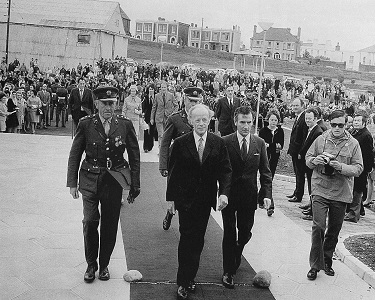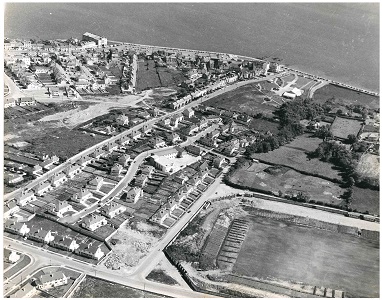Old Galway
LEISURELAND, 50 YEARS OLD

by Tom Kenny
The front page story on the first ever issue of the Galway Advertiser in 1970 was about the announcement of plans for a proposed new leisure centre to be situated between Revagh Road in Rockbarton and the Promenade.
On this day 50 years ago, June 29th 1973, the centre was formally opened by the President of Ireland, Erskine Childers. There had been some debate about what it should be called and eventually it would be known as Leisureland. It was only a section of the original plan but it was the first large-scale recreational facility in the west of Ireland. It featured an indoor heated swimming pool, a learner’s pool, a solarium, a multi-purpose hall, a cartoon cinema, outdoor and indoor amusements. Bórd Fáilte were the main investors with a significant input by Galway Corporation. The complex was designed by Simon Kelly and cost about £1 million pounds.
The swimming pool meant that swimmers in Galway could now swim and train all the year round. There was some disappointment in swimming circles that the pool was not 50 metres long, in other words, Olympic standard, and there was a rumour around at the time that for just £11,000 extra, they could have extended it. The pool was thirty three and a third metres long and of international standard. Indeed, a number of international galas have taken place there since as well as many national and local competitions.
THE BOY’S CLUB, 83 YEARS OLD AND STILL GOING

by Tom Kenny
Our Lady’s Boys Club was founded in 1940 by Fr. Leonard Shiel S.J. “to help young lads, flung into work at an early age when their characters are most easily formed for good or for ill. The Club hopes to play its small part in the present day effort all over Ireland to help poor boys to be more reliable and useful members of society and a credit to their faith”.
It has succeeded beyond Fr. Shiel’s wildest dreams.
Our President, Michael D. Higgins in a speech some years ago, said “Like so many successful community initiatives, Our Lady’s Boys Club was built on a vision, a spirit of participation and a will to make a genuine and positive difference to the community. When Fr. Shiel established a club in 1940, I doubt that he realised just how enduring his vision would be. Today, the Club is the largest youth club in the country and had woven its way into the fabric of community life in Galway, welcoming members from many neighbourhoods including Shantalla, Westside, Ballinfoile, Rahoon, Corrib Park and Newcastle.
PEARSE STADIUM, PÁIRC AN PHIARSAIGH

by Tom Kenny
Sixty six years ago this week, on June 16th 1957, Pearse Stadium opened.
The idea of the park originated with a meeting under the chairmanship of the Mayor on the 29th of April 1952, with six members of the Corporation, six members of the Chamber of Commerce and six members of the GAA, with the assistance of Ralph Ryan. A site of 17 acres was selected and terms of purchase successfully negotiated. The site was part of the original estate of Rockbarton conveyed by deed poll by the Commissioners of the Encumbered Estates in 1852. It later became part of the Hennessy Estate then the Corporation bought it for £3,000.
THE LEAVING CERT

by Tom Kenny
The Leaving Certificate, also known as Gaeilge as The Árd Teist, was first established in this country in 1924 and the first papers were marked in 1925. It is the final examination in the secondary school system and also serves as the University matriculation exam. There was a time when these two were separate exams. It is for the senior school cycle, most of the participants are 16 – 19 years old, although an increasing number of mature students now sit the tests.
The exams take place annually, usually at this time of the year (invariably accompanied by beautiful weather). Preparations normally take two years and repeating is permitted. The student can choose to sit a Pass paper or an Honours paper, the standard of questions being higher in the latter. In the old days, if you achieved 40% in a subject, you passed and 60% earned you an honours. Today, papers are graded from H1 down to H8.
SCOIL ÍDE, SEVENTY YEARS A-GROWING

by Tom Kenny
On this day seventy years ago, June 1st 1953, Scoil Íde opened for the first time. In 1952, the Sisters of Jesus and Mary purchased Allen’s Hotel on Dalysfort Road which had been run by John and Angela Allen. It had at one time been known as Daly’s Fort House, a high-class hotel run by a Mrs. Galbraith. She sold it to a Mr. Miller of Persse’s Distillers who used it as a private house and he sold it on to the Allens. Many will remember it as the place where Bruce Woodcock, the English Heavyweight champion, trained for his famous fight with Máirtín Thornton.
The Sisters converted the building into a school. Two of their congregation, Mother Mary Immaculata and Sister Celine, were given the job of setting it up. They lived in Spires House in Shantalla and every morning, Professor McKenna would give them a lift to Taylors Hill and they would walk from there, across the fields to the school where they were joined by teacher Miss Celia Burke.
TOMÁS BÁN AND HELENA CONCANNON

by Tom Kenny
Tomás Bán and his wife Helena were two people who made an outstanding contribution to the cultural enrichment of Galway and indeed of the country generally in the first half of the last century.
Tomás Bán was born on Inis Meáin on November 16th, 1870, the son of Páidín Concannon and his wife Annie Faherty. He was educated on the island and unusually for an islander, in the Monastery School in Galway. As a teenager, he was taken to the U.S. where he graduated with a MA in accountancy. He worked for a while in his brother’s vineyard in California, started a business in Mexico and it was there that he first began reading in the Irish language. He came back to Ireland in 1898 for a holiday but he became so immersed in the workings of the Gaelic League that he stayed and became their first ever organiser travelling the country at his own expense until they started paying him. He toured the U.S. in 1905 with Douglas Hyde on behalf of the League and they collected £20,000 for the cause. Tomás Bán worked in Monaghan until 1912 when he became a health inspector in Galway.
OF POSTMEN AND POSTWOMEN

by Tom Kenny
The regular use of the words ‘litir’ and ‘post’ in 15th century Irish manuscripts suggests that by that time a postal system was already in existence in Ireland. The English postal system was completely reformed by a man named Witherings in 1638 and he was then invited to do the same in Ireland. By the 1650s, mail was being carried by post boys who walked 16 – 18 miles a day between towns. It is believed the Galway Post Office was set up in 1653 when the Cromwellians were still here. In those early years, the local postmaster was expected to provide the premises, so every time a new postmaster was appointed, it meant a new main Post Office.
Most official Post Office archives were destroyed in the GPO during the 1916 Rising so early postal records are scarce. In 1663, the posts increased from once a week to twice a week on the three post roads from Dublin, the Cork Road, the Ulster Road and the Connaught Road but it could be dangerous driving the mail van. Some years ago, in this column, we reproduced a poster from 1837 offering a reward of five guineas for the recovery of mail bags lost on Christmas Eve between Galway and Tuam. For much of the 19th century, the mail coaches needed to be accompanied by two armed guards to discourage robberies.
“IT WAS IN THE AIR”

by Tom Kenny
Prior to 1961, public performance of Irish Traditional music in Galway took place primarily in the form of Céilís in large dancehalls – namely in the Hangar, the Commercial and the Astaire. These were enormously popular – remember the hundreds of bicycles parked outside the Hangar on a Sunday night – but they began to go out of fashion in the sixties and were regarded as old fashioned and backward.
Singing and music in pubs was generally frowned on and if you sang, you were likely to be thrown out. There were two exceptions to this, Cullen’s Bar in Forster Street and the Eagle Bar at the corner of William Street West and Henry Street. The owners, Martin Forde and Larry Cullen had an affinity with traditional music and musicians, but the sessions were intermittent and semi-private. In the Eagle, the recently formed (1956) branch of Comhaltas Ceoltóirí met and the Loch Lurgan Céilí Band used to rehearse.
